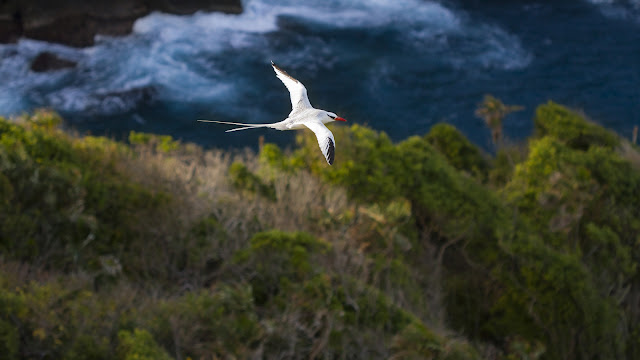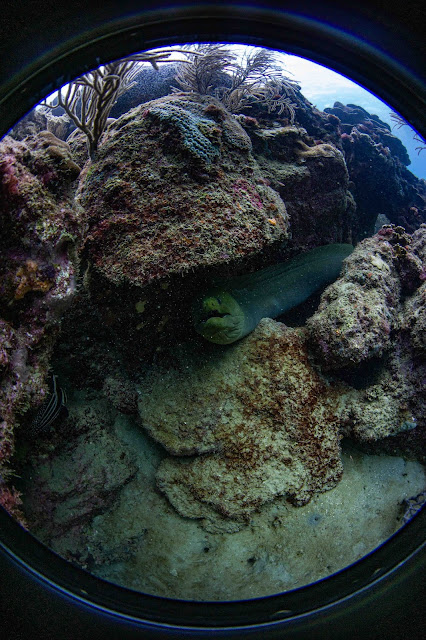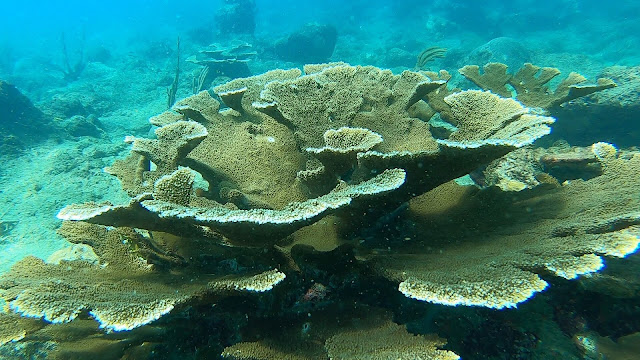Buccoo Reef is my backyard
We meet the boat at Buccoo. Solo Amor is bright with fresh paint on the jetty. No waves ruffle the calm of the bay. It’s late July. Brief daily showers cool the air. The Orinoco is not yet running in flood. Sky and sea off Tobago are clear. We board and find seats around the boxes that are picture frames to the sand bottom. As we motor out to the edge of the Buccoo Reef Marine Park, designated for protection since 1973, the underwater world comes alive. Corals, sea fans, fish and the occasional ray shimmy across our glass screens.
Edgar Johnson, captain of the Solo Amor, talks about the ocean backyard where he grew up. This area on the toe of Tobago includes Pigeon Point, Buccoo, Bon Accord and Store Bay, and was home and livelihood for his father’s family of ten children and now his family.
 |
Edgar Johnson is captain and commander of Solo Amor, a Buccoo Reef tour boat. Photo by Pat Ganase
|
“Fish Tea” was my nickname.
I grew up in Buccoo. My garden is in Buccoo Village. I was the second of ten children of James Ebenezer Johnson – they called him Daniel - and my mother Gertlyn. We were five boys and five girls, one went to Canada, one in England. Two were in the Coast Guard. One deceased.
My father was a fisherman all his life. There was another person before him called Daniel who gave his name to Dan’s Bank, that’s what the Nylon Pool used to be called, Dan’s Bank. There was a Johnson Bank, Bruce Bank, Top Elder Bank and Bottom Elder Bank, Cecil Bank. All named for people who were fishermen in Buccoo.
There are the Long Reefs, Gethsemane and Bull Head just beyond the reef. We had these names so we could identify and refer to different spots; and navigate between the dark spots.
The sea grass beds as well as the reef itself may be considered “dark spots.” Solo Amor has taken us out to the dark edge of the reef. Here the sea is green, with ripples and small waves. As we slip into the water, we feel the tug of a determined current and are warned to stay within reach of the safety ring attached to a long tow rope. With snorkels, masks and flippers, the littlest visitors swim above the corals, surprising a stingray and schools of fish. We are urged to hang on to the rope and hold fast as Solo Amor slowly takes us to the patch reef called Coral Gardens. These patch reefs are encircled by the fringing reef which encloses an area about seven sq km and includes the lagoon and mangrove swamp.
 |
| Diving with mask “just to look at the reef.” Photo by Anjani Ganase |
The Nylon Pool
I think I was about eight when I first went out on the reef. We used to dive with masks just to look at the reef.
When I was 14, I started working on the reef.
We used to go to the Nylon Pool at night looking for shells. There was a shell trade. We would collect the shells and the buyers, shell collectors, would come to see what we had.
In 1966, when we started going on the reef in the night, we couldn’t get our clothes wet, so we used to take off our clothes to dive.
Nylon Pool used to be called Dan’s Bank. After WW2 when the USA and UK made the first Nylon stockings, that was the sheerest fabric man had made. It is said that Princess Margaret came to Tobago on her honeymoon and called it the Nylon Pool. It’s really a sandbank in the middle of the reef. This made it popular and people said it has magical properties. The real magic is being able to live and work here every day.

The Nylon Pool they say has magical
qualities for men, women and couples who swim there. Photo by Anjani Ganase
The underwater world absorbs the young explorers diving and pointing and the grownups hanging on to the tow rope. We climbed to the flat roof of Solo Amor for the short ride to the Nylon Pool, an enchanting area where you can stand waist deep in clear water over a white sandy bottom. We idle there for about 30 minutes. The area is filling up with other boats, pulsating with soca music. On the shore at No Man’s Land, the “temporary” shacks are smoky with cook fires and the smell of barbecue wafts seaward.
Glass bottom boats
Fishermen used to set fish traps catching (parrot) fish to eat. There was a drastic change when people were taken out to the reef flat with shoes which mashed up the reef. When Gordon Grant owned Pigeon Point, they had some sophisticated boats and did tours turning over the coral. Up to the 1970s, there were lobsters on the reef. But when people found the holes where they lived, they all disappeared. The road to Pigeon Point was around the lagoon so you drove to the end where they now offer windsurfing.
Glass bottom boat tours started in the 1960s. Cecil Anthony went to Barbados and saw what they were using there. The glass was on top.
By 1965, the glass was turned to the bottom and the frame was sunk to replace the keel.
I was always driving boats in Buccoo for Sullivan Dillon. I learned straightening on cars but I liked boats. In 1966, I left school to follow my father.
I acquired my own boat because my mother helped by securing the loan at the bank for us.
Later, I got a glass bottom boat through a National Housing loan.
Solo Amor is about 25 years old. During the pandemic, she spent 18 months on land and we renovated her with marine ply and fibre glass.

Through the glass bottom, we see
corals, sea fans and fish nibbling the algae on the bottom of the boat. Photo
by Pat Ganase
At the end of Edgar Johnson’s Buccoo Reef tour, he brings the visitors close to No Man’s Land with a view of the calm lagoon. The sun is high in the sky and two hours at sea are taking their toll. Safety is a strong point in Johnson’s brief; and he is very concerned about unregistered “nameless” boats who take people into the marine park which is minimally patrolled. Boats ferrying passengers have to be registered and licensed. He believes that boats should have limits to the number of passengers.
Life saving
I trained with the Royal Life Saving Society 1967 to 1968 and became a lifeguard: one year in Buccoo, two in Mt Irvine and 27 years at Store Bay and Pigeon Point. I used to manage ten lifeguards in Pigeon Point and ten in Store Bay. We had equipment: jetskis, boats. I had to do timesheets, keep records, schedule shifts.
The rope barrier around Store Bay was my innovation. Jetskis had just come in. Barbados had already banned them on their bathing beaches.
Our team the Tobago Lifeguards used to play waterpolo at Marlins. And we made our waterpolo practice nets out of rope. It is this rope we used to cordon off the beach for the Great Race; and to keep the jetskis away from bathers. Jetskis should not be allowed in the marine park.
The village to raise our family
When Claudette and I got married in 1987, she had two children, I had two and we had two together. My first child is Karen. She got all of me. She is a diver, fishes lobster and conch, drives the patrol boat and is a caterer. We talk every morning. Every evening, I go to the garden. I always have green fig, ready to make a fresh fish broth.
Millions have come to Buccoo
In a peak year, visitors to the reef have been recorded at or around 120,000. In high season, July – August, there might be 15 boats or more per day. When the cruise ships come, they bring a few hundred visitors. Over the years, that is not an insignificant visitor count. Over the years, the traffic has taken its toll.
Many are missing on the reef now
I haven’t seen Rock Beauty in about 15 years. No Queen Triggerfish; no Long- jaw Squirrelfish.
We used to have huge schools of French Grunt; we are lucky to see a few young ones hiding in the Staghorn Coral. Of course, the Elkhorn Corals are gone. You will not see file fish if the water is dirty. Some things are coming back: the Staghorn coral and Spanish hogfish.
I have not seen Queen or any angelfish. And rarely butterfly fish.
At the end of our two hours on the reef, we have enjoyed an experience that cannot be matched anywhere else. We have had a peep into the vast underwater world, enough to leave a lasting impression; a reminder that ocean covers most of our planet. We also had the pleasure of meeting this “salt of the sea” personality who is a bridge to understanding what we require to live sustainably between land and sea.
 |
| Glass bottomed boat Solo Amor is Johnson’s place of work and business. Photo by Anjani Ganase |


